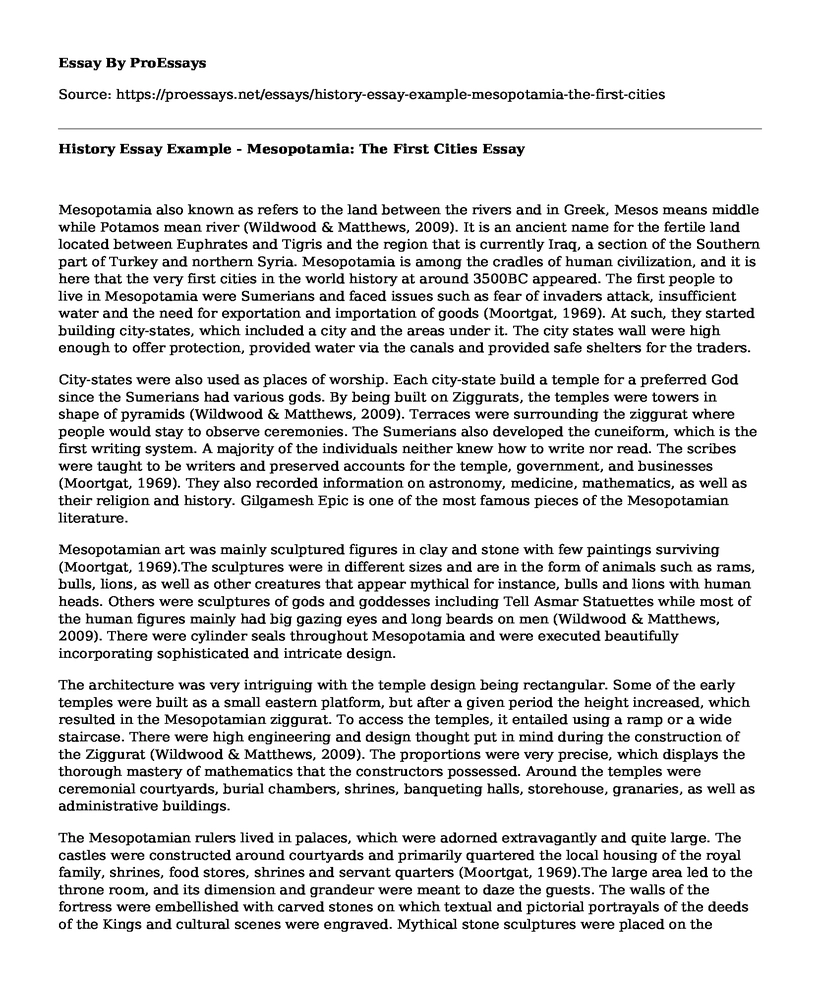Mesopotamia also known as refers to the land between the rivers and in Greek, Mesos means middle while Potamos mean river (Wildwood & Matthews, 2009). It is an ancient name for the fertile land located between Euphrates and Tigris and the region that is currently Iraq, a section of the Southern part of Turkey and northern Syria. Mesopotamia is among the cradles of human civilization, and it is here that the very first cities in the world history at around 3500BC appeared. The first people to live in Mesopotamia were Sumerians and faced issues such as fear of invaders attack, insufficient water and the need for exportation and importation of goods (Moortgat, 1969). At such, they started building city-states, which included a city and the areas under it. The city states wall were high enough to offer protection, provided water via the canals and provided safe shelters for the traders.
City-states were also used as places of worship. Each city-state build a temple for a preferred God since the Sumerians had various gods. By being built on Ziggurats, the temples were towers in shape of pyramids (Wildwood & Matthews, 2009). Terraces were surrounding the ziggurat where people would stay to observe ceremonies. The Sumerians also developed the cuneiform, which is the first writing system. A majority of the individuals neither knew how to write nor read. The scribes were taught to be writers and preserved accounts for the temple, government, and businesses (Moortgat, 1969). They also recorded information on astronomy, medicine, mathematics, as well as their religion and history. Gilgamesh Epic is one of the most famous pieces of the Mesopotamian literature.
Mesopotamian art was mainly sculptured figures in clay and stone with few paintings surviving (Moortgat, 1969).The sculptures were in different sizes and are in the form of animals such as rams, bulls, lions, as well as other creatures that appear mythical for instance, bulls and lions with human heads. Others were sculptures of gods and goddesses including Tell Asmar Statuettes while most of the human figures mainly had big gazing eyes and long beards on men (Wildwood & Matthews, 2009). There were cylinder seals throughout Mesopotamia and were executed beautifully incorporating sophisticated and intricate design.
The architecture was very intriguing with the temple design being rectangular. Some of the early temples were built as a small eastern platform, but after a given period the height increased, which resulted in the Mesopotamian ziggurat. To access the temples, it entailed using a ramp or a wide staircase. There were high engineering and design thought put in mind during the construction of the Ziggurat (Wildwood & Matthews, 2009). The proportions were very precise, which displays the thorough mastery of mathematics that the constructors possessed. Around the temples were ceremonial courtyards, burial chambers, shrines, banqueting halls, storehouse, granaries, as well as administrative buildings.
The Mesopotamian rulers lived in palaces, which were adorned extravagantly and quite large. The castles were constructed around courtyards and primarily quartered the local housing of the royal family, shrines, food stores, shrines and servant quarters (Moortgat, 1969).The large area led to the throne room, and its dimension and grandeur were meant to daze the guests. The walls of the fortress were embellished with carved stones on which textual and pictorial portrayals of the deeds of the Kings and cultural scenes were engraved. Mythical stone sculptures were placed on the walkways and at the gate. Outside the palaces were parks and gardens full of wild animals.
The house materials were not any different from those currently used including the sunbaked bricks, wooden doors and mud plasters (Moortgat, 1969). All the building materials were available naturally in the area. The majority of the big houses were built around a courtyard and had a large room for lounging and receiving guests on one side and private family rooms right after it. There was servant quarters, store rooms and the kitchen on the other side of the courtyard (Wildwood & Matthews, 2009). On the other hand, the houses for the poor were built using reeds and mud and were found outside city walls in the shanty villages.
Life for the ancient Mesopotamians was not very different from the life people live today. The modern world might have had significant advances in technology, but the Mesopotamian art and architecture left some impressively built forms and visual arts that will remain in our arts and history books for a very long time.
References
Moortgat, A. (1969). The art of ancient Mesopotamia: the classical art of the Near East. Phaidon Press.
Wildwood, G., & Matthews, R. (2009). Ancient Mesopotamian Civilization. The Rosen Publishing Group.
Cite this page
History Essay Example - Mesopotamia: The First Cities. (2021, Apr 01). Retrieved from https://proessays.net/essays/history-essay-example-mesopotamia-the-first-cities
If you are the original author of this essay and no longer wish to have it published on the ProEssays website, please click below to request its removal:
- Child's Developmental Needs - Paper Example
- Gender and Family Structure Essay
- Reflection Paper on Sweat Lodge by Bryan Little Chief
- Pima Creation Story Essay Example
- Annotated Bibliography on Zimbabwe (Rhodesia)
- Haru in the Garden
- Essay Sample on 7 Key Aspects of Cultural Diversity: Respecting Differences, Empowerment & Max Potential







